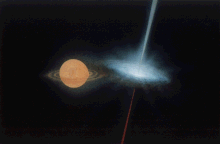Rentgenová dvojhvězda

Rentgenová dvojhvězda je těsná dvojhvězda, která vysílá rentgenové záření. Jedna z dvojice rentgenové dvojhvězdy je malá kompaktní degenerovaná hvězda s obrovskou gravitační potenciální energií. Druhá složka je většinou plazmová hvězda, z níž uniká plazma. Gravitační potenciál urychluje elektrony a ionty mezi plazmovou a degenerovanou hvězdou, přičemž vzniká brzdné záření.
Reference
V tomto článku byl použit překlad textu z článku Röntgenová dvojhviezda na slovenské Wikipedii.
Média použitá na této stránce
SS433 is one of the most exotic star systems known to astronomers. Its unremarkable name stems from its inclusion in a catalog of stars which emit radiation characteristic of atomic hydrogen. Its very remarkable behavior stems from a compact object, a black hole or neutron star, which has produced an accretion disk with jets. As illustrated in this artist's vision of the SS433 system based on observational data, a massive, hot star (left) is locked in a mutual orbit with a compact object. Material transfers from the massive star into an accretion disk surrounding the compact object blasting out two jets of ionized gas in opposite directions - at about 1/4 the speed of light! Radiation from the jet tilted toward the observer is blueshifted, while radiation from the jet tilted away is redshifted. The binary system itself completes an orbit in about 13 days while the jets precess (wobble like a top) with a period of about 164 days. Are the jets from SS433 related to those from black holes at the centers of galaxies?
